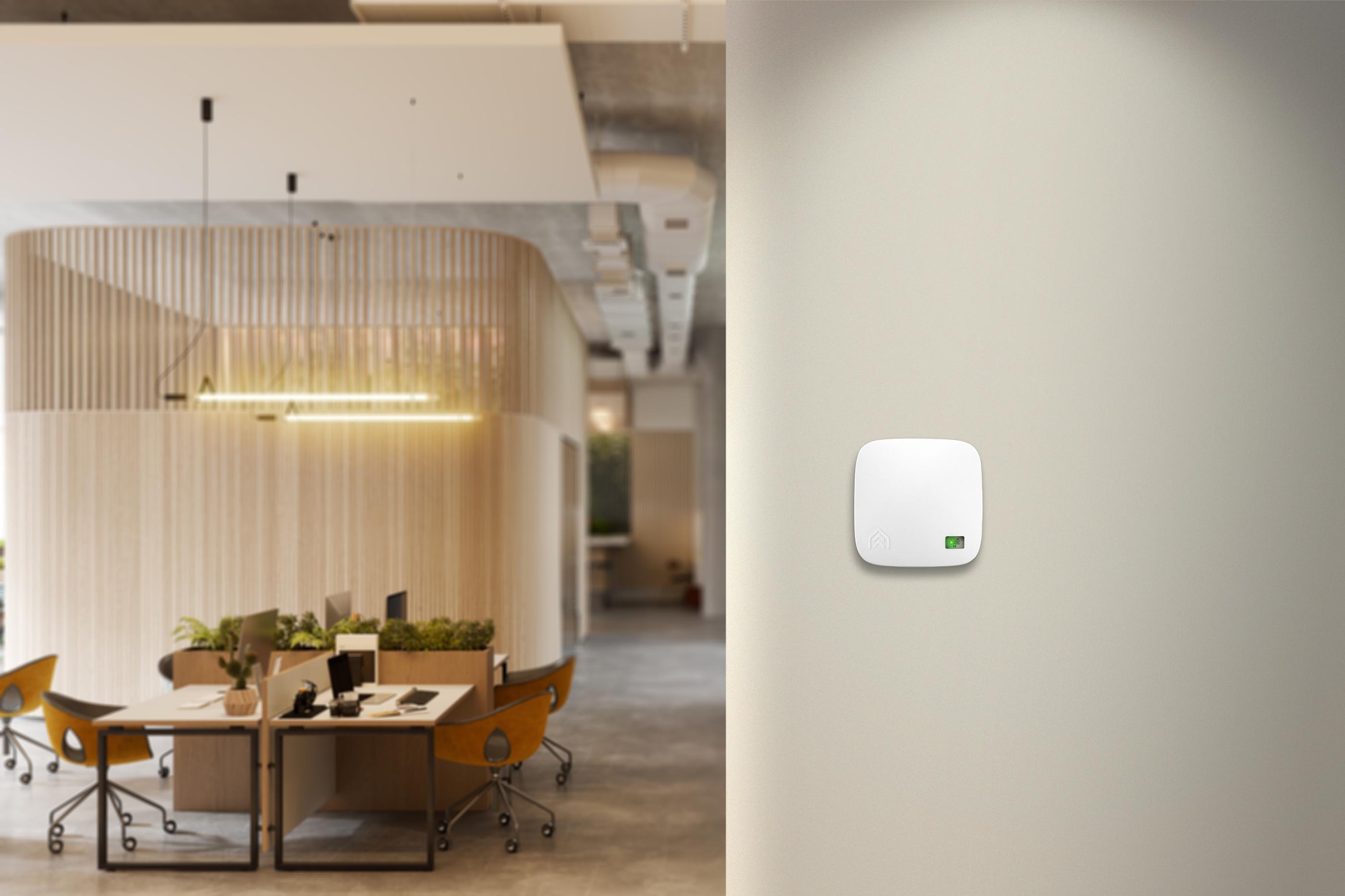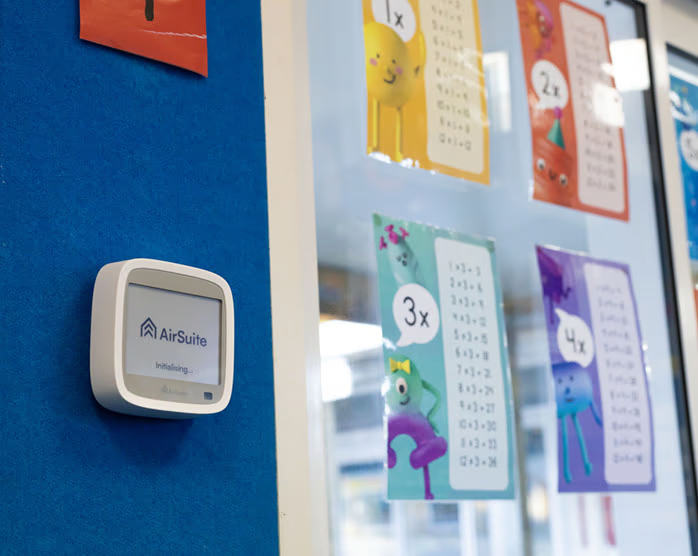
Support
Get help with setting up and using AirSuite sensors and software.
Deep dive: Particulate Matter
All you need to know about measuring Particulate Matter (PM) with AirSuite monitors.
If you want to learn more about how your PM sensors work under the hood, you’re in the right place. Read on to discover:
- The dangers of high exposure to PM;
- How the sensors operate;
- How they calibrate, and;
- Technicalities to keep in mind.
I want to measure particles like mould spores, dust, or exhaust fumes. What do I need?
AirSuite offers a range of “add-on” sensors for detecting these types of particles and gases.
These add-ons are available to be factory-fitted into our base model AirSuite devices before they are shipped for you.
The following add-ons are available:
- Particulate Matter (PM) add-on, which measures PM2.5 and PM10;
- Carbon Monoxide (CO) add-on, which measures CO;
- The Biochem Lite add-on, which measures CO and Formaldehyde (CH₂O);
- The Biochem Pro add-on, which measures CO, CH₂O, Nitrogen Dioxide (NO₂), and Ozone (O₃).
Please note that in all cases, these add-ons replace the battery that is normally fitted in the base model AirSuite devices (if applicable). This means that you will not be able to run the device on battery power, and it will need to be plugged into a power source at all times.
Tell me more about PM - what does it mean?
A mix of solid particles and liquid droplets in the air, particulate matter or PM come in various sizes and compositions. The sources are both natural - like dust storms and forest fires - and human made - like emissions from factories, vehicles and construction sites.
Invisible to the naked eye, PM is categorised by size and measured in micrometres (µm).
The two most talked about are PM2.5 (combustion particles, organic compounds, metal, etc - particles with a diameter of 2.5 micrometres or smaller) and PM10 (dust, pollen, mould, etc - particles with a diameter of 10 micrometres or smaller).
The finer the particles, for example PM2.5, the greater the risk, as they can find their way deep into the respiratory system, including the lungs and heart, and even enter the bloodstream.
What do AirSuite PM sensors measure?
These sensors measure the mass and number concentrations of particles in the air like mould spores, dust and exhaust fumes. Different PM sizes are measured in categories like PM10 and PM2.5 (see above).
AirSuite devices contain an optical particle counting PM sensor. The sensor shines a laser through the air and measures the amount of light scattered by particles in the air. The more light scattered, the more particles are present.
All low-cost, consumer-grade PM sensors on the market today are optical particle counters. They are capable of measuring PM1 and PM2.5 with a level of accuracy that is acceptable for most applications, while PM4 and PM10 measurements are less accurate, because they are extrapolations from smaller particle measurements, based on typical aerosol profiles.
What’s the difference between mass concentration and number concentration?
Mass concentration represents the total weight of particles present in a given volume of air, measured in micrograms per cubic metre (µg/m³). This measurement provides information on the overall mass of particles, regardless of their individual size or number.
On the other hand, number concentration quantifies the actual number of particles within a given volume of air, regardless of their individual mass, expressed as the number of particles per unit volume of air. Mass concentration is the measurement typically referred to in most research and guidelines (e.g. those recommended by WHO).
The mass concentration and number concentration tend to be very closely correlated when there is a consistent distribution of particle sizes over time. But they can sometimes differ - when there is a moderate spike in mass concentration, but where the mass is dominated by small particles (e.g. PM1), the number of particles is likely to be higher.
How do I know if PM levels are healthy and safe?
High PM levels can indicate problems like mould growth or poor air quality. The World Health Organization (WHO) has recommended thresholds for safe daily PM exposure.
AirSuite provides recommendations on healthy range recommendations for each attribute measured by your AirSuite sensors on this support page.
What do WHO air quality guidelines recommend?
If you’re interested in some further reading - plus a breakdown on WHO’s updated air quality guidelines (as at 2021) - please visit their website, where you can read the full report, executive summary and more about air quality and health.
How do AirSuite’s PM sensors work?
Using a built-in fan, the PM sensors actively draw in surrounding air for measurement. This is different from VOC sensors which are passive.
The PM sensor takes readings every 15 minutes to avoid interfering with other sensors - running the fan moves the air around and could skew your other measurements slightly if it was on constantly.
How can I enable alerts for PM and what should I alert on?
First, follow our instructions to configure the thresholds, and enable organisation-wide notifications for PM2.5. We recommend alerting on PM2.5 instead of PM10, as PM2.5 measurements are more accurate.
Then, you can enable or disable email notifications for alerts triggered by devices in your organisation(s) in the My Account page of the Portal.
On this page, you can configure:
- Which organisations or specific deployments you receive alerts for
- Which category of alerts you receive (environmental or diagnostics)
- Whether you receive notifications at the ‘warning’ or ‘critical’ threshold, or both
- The delay (minimum continuous active time) before a notification is sent
How can I tell if mould levels are increasing?
If your PM10 level is really high, but your PM2.5 level is quite low, this can be an indication there is mould growth or mould spores in the air. On the other hand, if your PM2.5 levels are quite high, but your PM10 levels are relatively low, this is a sign you have a different problem.
How do I interpret the data?
For the most meaningful data, focus on establishing baseline readings for your specific environment over several weeks. Note any recurring patterns - perhaps readings are consistently higher in the morning due to overnight accumulation, or spike during certain activities. Document any correlations between readings and activities, as this context makes the data far more actionable than the raw numbers alone.
Sharp spikes in PM readings typically indicate immediate sources like cooking, cleaning activities, or someone entering from outdoors, while gradual increases over hours or days may suggest ongoing sources like construction nearby, degrading building materials, or seasonal factors like increased pollen. Understanding these patterns helps distinguish between temporary events and persistent air quality issues that may require intervention.
AirSuite reports include colour-coded zones (green for good, red for bad) based on expert recommendations. However, these should be used only as a guide, due to it being hard to rely on the absolute readings of the VOC sensor, as discussed above. Therefore, they are not a substitute for expert analysis.
We’ve noticed some ongoing problems with our indoor air quality. What should we do?
It depends on what’s happening in your space. If it’s a factory environment, the solution may be obvious like installing some extraction fans. If you’ve investigated the cause and the answer is not immediately clear, it could be worthwhile to consult a specialist who can advise you on the best course of action to improve your indoor air quality.
While PM sensors excel at detecting the presence and concentration of particles, they cannot assess health risks without context. Consistently elevated readings, especially PM2.5 levels that remain above WHO guidelines, warrant professional investigation. A qualified indoor air quality specialist can perform detailed particle identification, source tracking, and provide specific remediation recommendations based on your particular environment and particle composition.
A specialist will take particulate matter samples and send them to a laboratory for analysis. This will help you identify the source of the problem and take the necessary steps to improve your indoor air quality.
Understanding PM Sensor Accuracy Limitations
While optical particle counters provide valuable real-time data, they have inherent limitations compared to reference-grade instruments. The accuracy can vary depending on particle composition - for example, the sensor may respond differently to water droplets versus dust particles of the same size, as different materials scatter light differently. Additionally, very high humidity can affect readings, as water vapour can interfere with the laser measurement system or cause particles to grow in size.
Particle Composition vs. Size Measurements
It’s important to understand that PM sensors measure particle size but cannot identify particle composition. A PM2.5 reading of 50 µg/m³ could represent harmless salt particles from coastal air, dangerous combustion particles from traffic, or biological particles like bacteria. This is why correlating PM readings with known activities and sources in your environment is crucial for proper interpretation.
Do you supply devices that measure both PM and CO, or other combinations?
Currently, we do not supply devices that measure both PM and CO, or other combinations. This is because the size of each sensor means they cannot fit into the same device.
Can you supply devices that measure PM or CO with a battery?
AirSuite Sense Wi-Fi is fitted with a small rechargeable battery in addition to any selected add-on. However, this battery is only intended for short-term use, such as to keep the device running during power outages. It does not provide enough power to run the device for longer than a day at a time, so it should be plugged into a power source at all times.
All AirSuite LTE devices (Sense LTE, Glance LTE) cannot be fitted with a battery in addition to an add-on, because the size of the battery is too large to fit alongside the add-on sensor.
Alerts
- Configure alert thresholds
- Email Notifications
- Manage Alerts
- Mobile App Notifications
- Our Recommendations
Connectivity
- Battery Life
- LTE Coverage Guide
- Over-the-air Updates
- Troubleshoot Inactive LTE devices
- Troubleshoot Inactive Wi-Fi devices
- Wi-Fi Access Point Compatibility
- Wi-Fi or LTE?


